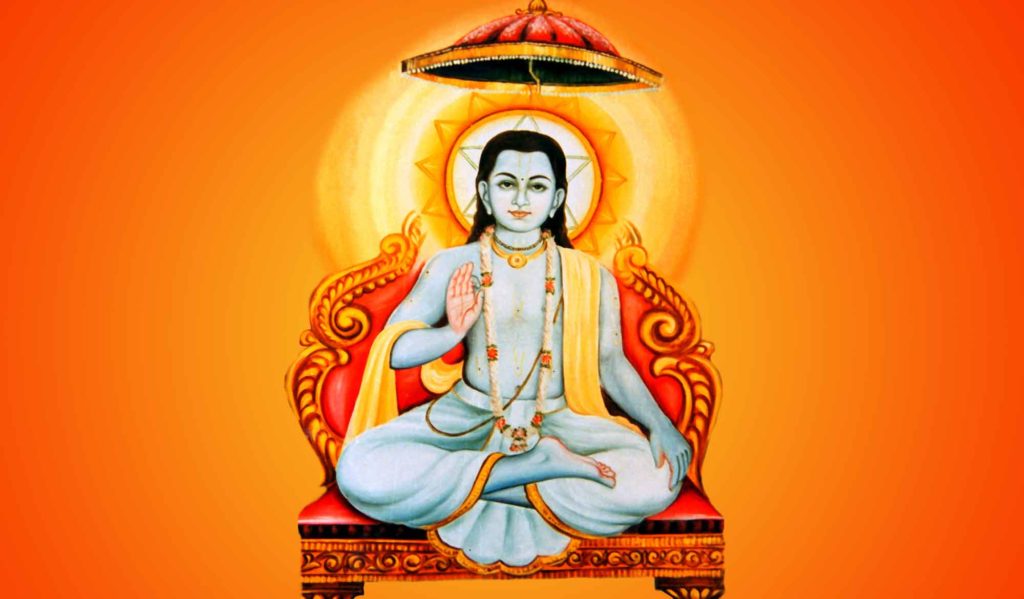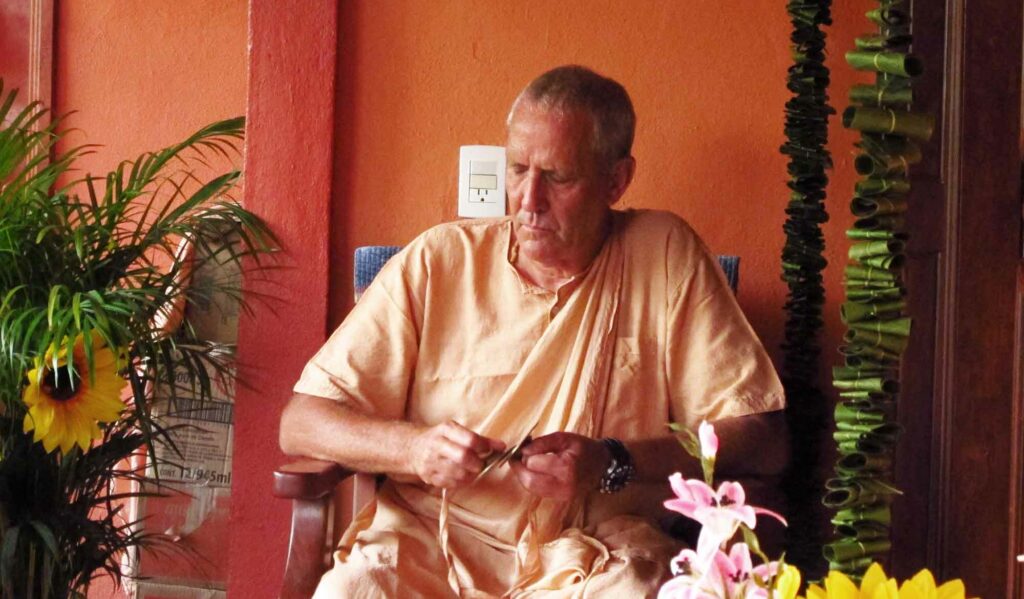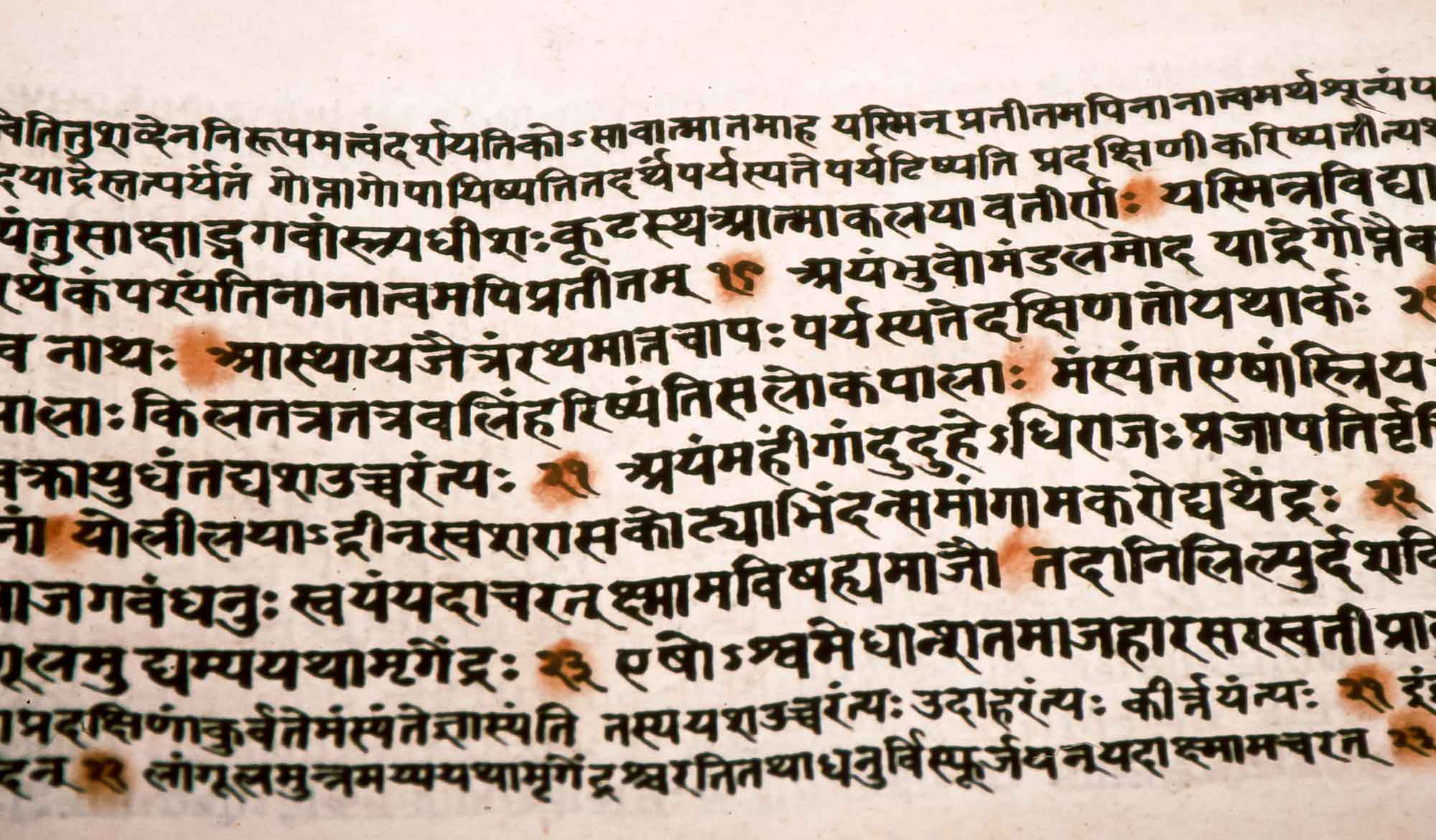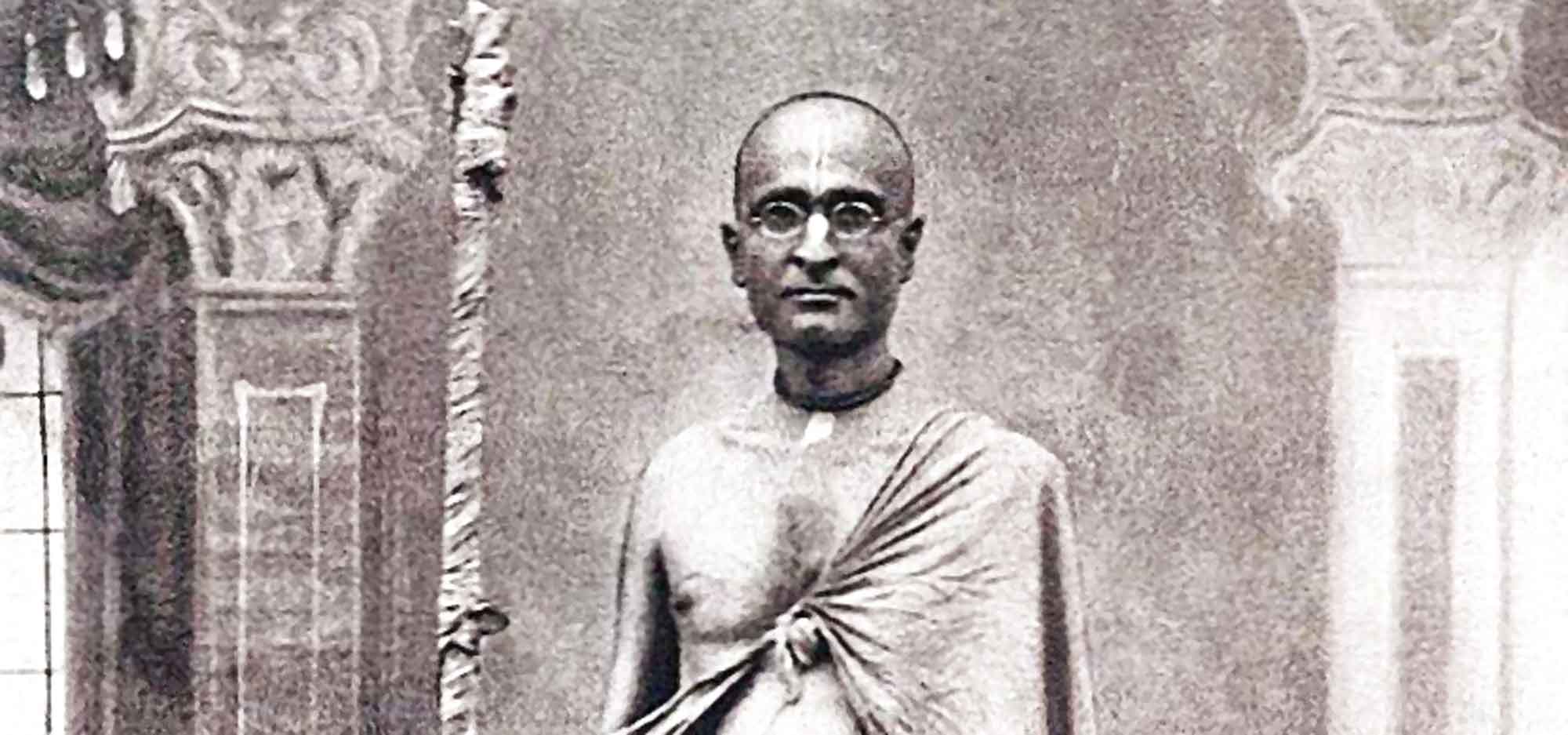by Swami B.G. Narasingha
'Nityānanda Avadhūta' was written by Swami Narasingha in 2002 in response to some sections of devotees who claimed that Nityānanda Prabhu was previously a sannyāsī. Narasingha Maharaja quotes Sarasvatī Ṭhākura and Śrīla Śrīdhara Mahārāja who categorically state that this was not the case.
Devotee: It has been stated by some persons who claim to follow the pure line of devotion presented by Śrīla Prabhupāda Sarasvatī Ṭhākura, that Śrī Nityānanda Prabhu was a sannyāsī who later gave up His sannyāsa and married the two daughters of Sūrya Vipra. Is this a fact?
Narasiṅgha Mahārāja: No, this is not a fact. This is an idea that is commonly put forth by the sahajiyā and bābājī communities, but it is not so. This concocted idea has not been accepted by Śrīla Sarasvatī Ṭhākura or his followers. One who says that Śrī Nityānanda Prabhu gave up sannyāsa is an offender to the Supreme Lord. At least it must be concluded that such a person is a victim of a poor fund of knowledge.
An attempt has been made to substantiate that Śrī Nityānanda Prabhu was formerly a sannyāsī by quoting from Śrīla Vṛndāvana Dāsa Ṭhākura’s Śrī Caitanya-bhāgavata, wherein the following verses are found.
kothāya thākila daṇḍa kothā kamaṇḍalu
kothā vā vasana gela nāhi ādi-mūla
“Where was His daṇḍa, where was His water-pot, and where were His clothes? Nothing remained with Him.” (Caitanya-bhāgavata, Madhya-khaṇḍa 5.62)
katho rātre nityānanda huṅkāra kariyā
nija-daṇḍa-kamaṇḍalu phelilā bhāṅgiyā
“In the dead of night, Nityānanda suddenly roared loudly and broke His daṇḍa and water-pot.” (Caitanya-bhāgavata, Madhya-khaṇḍa 5.67)
The references here to daṇḍa and kamaṇḍalu are enough to convince the sahajiyās that Śrī Nityānanda Prabhu was previously an initiated sannyāsī. Some sahajiyās are even of the opinion that Śrī Nityānanda Prabhu was a sannyāsī-disciple of Śrī Lakṣmīpati Tīrtha, but there is no evidence for this whatsoever. In this regard, Śrīla Sarasvatī Ṭhākura has stated in his purports to the above verses that the daṇḍa and kamaṇḍalu are not only symbols of the sannyāsa-āśrama, they are also used by brahmacārīs. The brahmacārī daṇḍa is made from either khadira, palāśa or bamboo and when an upakurvāṇa–brahmacārī decides to enter householder life, he discards the daṇḍa. This is exactly what Lord Nityānanda did.
Some persons are of the opinion that Śrī Nityānanda Prabhu held the sannyāsa title Ānanda, but according to the Sātvata-saṁhitā, Ānanda is not one of the 108 names of a sannyāsī. Ānanda is sometimes used by the Advaitin section as a name (such as Prakāśānanda, Svarūpānanda, Brahmānanda etc), but their actual sannyāsa title is one of the daśa-nāmi; Tīrtha, Āśrama, Vana, Āraṇya, Pārvata, Giri, Sāgara, Sarasvatī, Bhāratī and Purī.
Further evidence to suggest that Śrī Nityānanda Prabhu was a brahmacārī and not a sannyāsī is given in Śrīla Sarasvatī Ṭhākura’s commentary to verse 9 of the fifth chapter in the Madhya-khaṇḍa of Caitanya-bhāgavata as follows:
“Jagad-guru Śrī Nityānanda Prabhu was a brahmacārī disciple of Parivrājakācārya Śrī Lakṣmīpati Tīrtha, who enacted the pastimes of subordination to the Śrī Madhva sampradāya. We find His brahmacārī name was Śrī Nityānanda Svarūpa. From ancient times brahmacārī disciples of Tīrtha and Āśrama sannyāsīs have been addressed as Svarūpa.”
Again, Śrīla Prabhupāda Sarasvatī Ṭhākura writes:
“The brahmacārī name of Nityānanda Prabhu was Svarūpa. Since Svarūpa is the brahmacārī name of a Tīrtha sannyāsī’s disciple, some people consider Him to be a follower of Lakṣmīpati Tīrtha rather than a follower of Mādhavendra Purī.” (Purport to Caitanya-bhāgavata, Madhya-khaṇḍa 5.67)
The revered Guardian of Devotion Oṁ Viṣṇupada Śrīmad Bhakti Rakṣaka Śrīdhara Deva Gosvāmī Mahārāja has commented on this topic thus.
“Nityānanda was not a sannyāsī, He was a brahmacārī. He performed Vyāsa-pūjā in Śrīvāsāṅgana. There some say that He was a sannyāsī, but there He had no special garment either for sannyāsī or brahmacārī. He was a very independent spirit.” (81.09.23)
“That Nityānanda was a sannyāsī, it is not a proven fact. The Nityānanda, this is Ānanda, this indicates the affix added to brahmacārī. Ānanda, Svarūpa, Prakāśa, all these types of brahmacārī. Ānanda, a name also in the sannyāsī we find, but no other title. Ānanda is a part of the name but title, no title of Nityānanda. And also no mention who was the sannyāsa-guru of Nityānanda. But dīkṣā-guru of Nityānanda is Mādhavendra Purī, it is known. Avadhūta does not mean who is sannyāsī. Avadhūta means who is not very particular of his external practices and sometimes commits something wrong which should not be committed, should not be practiced. When lower practices are seen in connection with the high-level person then they are considered as avadhūta. He is above that but his practices are of lower nature. Ava means lower; dhūta – that also he can either remove or he can purify.” (82.02.06)
Furthermore, Śrīla Vṛndāvana Dāsa Ṭhākura himself is of the opinion that Nityānanda was not a sannyāsī and has written:
kibā yati nityānanda kibā bhakta jñānī
yā’ra yena mata icchā nā bolaye keni
“Some may consider Nityānanda to be a sannyāsī. Others may consider Him to be a devotee or a jñānī. They may say whatever they like.” (Caitanya-bhāgavata, Ādi-khaṇḍa 9.223)
Another so-called evidence that the sahajiyās present to establish their concocted idea that Śrī Nityānanda Prabhu took sannyāsa is found in Caitanya-bhāgavata, Madhya-khaṇḍa 13.15 and 19:
ājñā śire kari nityānanda-haridāsa
tata-kṣaṇe calilena pathe āsi hāsa
“Taking the order of Śrī Caitanya upon their heads, Nityānanda and Haridāsa immediately went out, laughing together in a happy mood.”
dohāna sannyāsī-veśa-yāna yāra ghare
āthe-vyathe āsi bhikṣā-nimatraṇa kare
“Wherever they went to beg, the householders would extend invitations to them as they were both dressed in the robes of sannyāsīs.”
If we are to take it that the above verse proves that Nitāi was a sannyāsī, then following such logic we must also believe that Ṭhākura Haridāsa was a sannyāsī! Actually neither were sannyāsīs.
Due to the social etiquette of that time, it would have been unthinkable for a Muslim such as Haridāsa to take the vows of sannyāsa since only those born in brāhmaṇa families could formally take to the formal renounced order of life. Simply because they were dressed as mendicants does not necessarily mean that they had actually accepted sannyāsa. This type of unorthodox behaviour was common with Śrī Nityānanda Avadhūta and on that day he had dragged Haridāsa Ṭhākura into His plot.
If indeed Śrī Nityānanda Prabhu had formally taken sannyāsa, why is there no mention of such an important event in any Gauḍīya literature? Why is there no mention of his sannyāsa-guru?
Śrīla Sarasvatī Ṭhākura came to re-establish the system of daivi-varṇāśrama, in particular to re-introduce tridaṇḍi-sannyāsa in the Gauḍīya line for the purpose of preaching love of God. But those persons who oppose Sarasvatī Ṭhākura have tried to minimize his contribution by creating false stories to show that even Śrī Nityānanda Prabhu gave up His sannyāsa. One important point that the sahajiyās conveniently overlook is that in order to preach love of God, Śrī Caitanyadeva Himself accepted sannyāsa.
In order to attain the mercy of Śrī Caitanyadeva, one must first beg for the mercy of Śrī Nityānanda Prabhu. If one’s crippled mind, however, concocts imaginary proofs that simply degrade the position of the Śrī Nityānanda Prabhu then such a person is truly most unfortunate.
POSTSCRIPT: During the time of Sarasvatī Ṭhākura, Śrīmad Bhakti Pradīpa Tīrtha Mahārāja wrote in his book, ‘Ācāra o Ācārya‘ the following:
Śrī Nityānanda Prabhu is an avadhūta paramahaṁsa, but in spite of admitting this no one should dare to call him ‘vāntāśī‘ (a person who has fallen away from sannyāsa, ‘a vomit-eater’), as this would be only aparādha. This is not teachings/tradition of Mahāprabhu to make a sannyāsī as a householder.
To claim that Śrīman Mahāprabhu or Nityānanda Prabhu were doing some improper or stupid activities – if someone says like this, then it is clearly seen that such vile talks belong to the category of sahajiyā. And all talks about preserving proper order (maryādā) by succession of sons from the bodily fathers are also downright contemptible and laughable. This kind of statements produced by sahajiyās are worthy of non-Vaiṣṇavas. The sampradāya can never be preserved by the dharma of mundane householders (gṛha-vrata-dharma). ‘Advaita-Prakāśa‘ and other such books are thoroughly unauthorized (apramāṇika, not proved by śāstras), opposite to tattva, revealed Truth (tattva-viruddha) and is the literary creation of sahajiyās.
More Articles by Swami B.G. Narasingha
Have the Vedas Advanced Civilization?
“Have the Vedas Advanced Civilization?” was a short article written by Śrīla Narasiṅgha Mahārāja in 2000 in response to a question by a young Indian student. Śrīla Narasiṅgha Mahārāja responds by defining civilization, and giving examples of how the Vedas have helped mankind.
Why We Fight
‘Why We Fight’ by Swami B.G. Narasingha was first published on October 9th 2006. In this article, Swami Narasingha explains why it is the duty of Gauḍīya Vaiṣṇavas, in particular tridaṇḍi-sannyāsīs, fight against māyā and misconception.
The Struggle for Consciousness
‘The Struggle for Consciousness’ was written by Swami B.G. Narasingha and first published in Gaudiya Touchstone, Issue 2 in 2014. In this essay, Narasingha Maharaja discusses the topic of consciousness and how many leading scientists such as Robert Lanza are postulating that life comes from consciousness.













